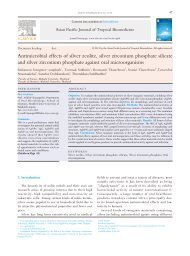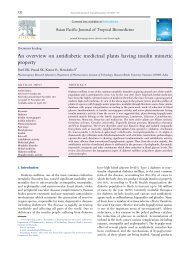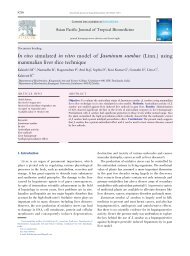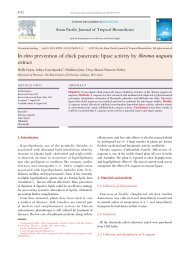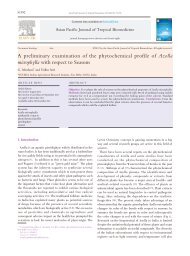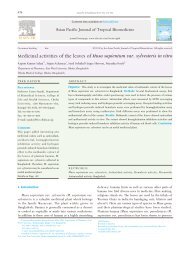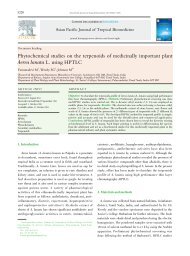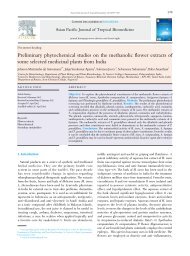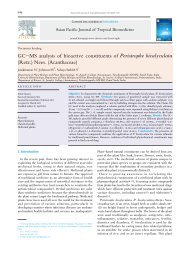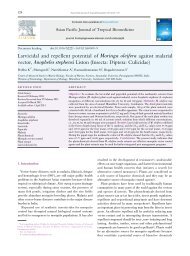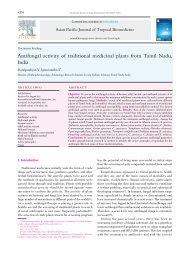Pharmacological properties of Datura stramonium L. as a - Apjtb.com
Pharmacological properties of Datura stramonium L. as a - Apjtb.com
Pharmacological properties of Datura stramonium L. as a - Apjtb.com
Create successful ePaper yourself
Turn your PDF publications into a flip-book with our unique Google optimized e-Paper software.
icons at temples. An extract made from the leaves is taken<br />
orally for the treatment <strong>of</strong> <strong>as</strong>thma and sinus infections,<br />
and stripped bark are applied externally to treat swellings,<br />
burns and ulcers. The incidence <strong>of</strong> D. <strong>stramonium</strong> poisoning<br />
is sporadic with a cluster <strong>of</strong> poisoning c<strong>as</strong>es in the 1990s<br />
and 2000s, the United States media reported some c<strong>as</strong>es<br />
occurring mostly among adolescents and young adults dying<br />
or be<strong>com</strong>ing seriously ill from ingesting. Some medicinal<br />
uses <strong>of</strong> the plant are its anti-inflammatory property <strong>of</strong><br />
all parts <strong>of</strong> the plant, stimulation <strong>of</strong> the central nervous<br />
system, respiratory decongestion, treatment <strong>of</strong> dental and<br />
skin infections, alopecia and in the treatment <strong>of</strong> toothache.<br />
It is a hallucinogenic plant that causes serious poisoning.<br />
Consumption <strong>of</strong> any part <strong>of</strong> the plant may result in a<br />
severe anticholinergic reaction that may lead to toxicity<br />
and occ<strong>as</strong>ionally cause diagnostic difficulties. C<strong>as</strong>es <strong>of</strong><br />
poisoning have been reported after eating the berries.<br />
Death may occur from heart failure after ingesting 125<br />
seeds, because the seeds contain the highest concentration<br />
and h<strong>as</strong> a rapid onset <strong>of</strong> action, thus may be potentially<br />
useful <strong>as</strong> an alternative to atropine for the treatment <strong>of</strong> the<br />
muscarinic symptoms <strong>of</strong> organophosphate toxicity and some<br />
<strong>of</strong> central anticholinergic effects. The wide distribution,<br />
the strong toxicity and the potential for occurrence in<br />
foodstuffs are responsible for the numerous incidents in<br />
humans[2]. <strong>Datura</strong> genus distributes over tropical and warm<br />
temperate regions <strong>of</strong> the world. About ten species <strong>of</strong> <strong>Datura</strong><br />
are found, <strong>of</strong> which <strong>Datura</strong> anoxia and D. stromonium are<br />
most important drug plants. <strong>Datura</strong> h<strong>as</strong> long been known<br />
<strong>as</strong> a medicinal plant and <strong>as</strong> a plant hallucinogen all over<br />
the world. Pre-historic use <strong>of</strong> <strong>Datura</strong> in medicinal and<br />
ceremonial rituals could be observed in aboriginal in Indian<br />
sub-continent[3]. The therapeutic activities <strong>of</strong> most plants<br />
are due to the presence <strong>of</strong> one or more <strong>of</strong> such <strong>com</strong>ponents<br />
like alkaloids, tannins, saponins and cardiac glycosides.<br />
The phytochemical screening revealed the presence <strong>of</strong><br />
saponins, tannins, steroids, alkaloids, flavonoids, phenols<br />
and glycosides[4].Atropine and scopolamine are <strong>com</strong>petitive<br />
antagonists <strong>of</strong> muscarinic cholinergic receptors and are<br />
central nervous system depressants. All parts <strong>of</strong> the plant<br />
are toxic, but the highest amount <strong>of</strong> alkaloids is contained<br />
in the ripe seeds[4,5]. Many c<strong>as</strong>es <strong>of</strong> accidental poisoning by<br />
D. <strong>stramonium</strong> have been reported when these plants were<br />
eaten accidentally[6].<br />
Figure 1. <strong>Datura</strong> <strong>stramonium</strong>.<br />
a: <strong>Datura</strong> plant (leaves and flowers); b: D. <strong>stramonium</strong> fruit; c: D. <strong>stramonium</strong> flower.<br />
Priyanka Soni et al./Asian Pac J Trop Biomed 2012; 2(12): 1002-1008 1003<br />
2. Regional and other names<br />
Sanskrit: Umatta-virkshaha<br />
English: Thornapple<br />
Hindi: Sadah-<strong>Datura</strong>, Safed <strong>Datura</strong><br />
Tamil: Umatai<br />
Arab: Jonz-m<strong>as</strong>al<br />
Gujrat: Dhatoria<br />
Bengali: Dhattura<br />
Malayalam: Maraummam<br />
Marathi: Kanaka<br />
3. Scientific cl<strong>as</strong>sification <strong>of</strong> D. stromonium<br />
Kingdom: Plantae<br />
Division: Magnoliophyta<br />
Cl<strong>as</strong>s: Magnoliopsida<br />
Order: Solanales<br />
Family: Solanaceae<br />
Genus: <strong>Datura</strong><br />
Species: <strong>Datura</strong> stromonium<br />
4. Botanical description<br />
4.1. Plant appearance<br />
D. <strong>stramonium</strong> is an annual plant (Figure 1). The stem is<br />
herbaceous, branched and glabrous or only lightly hairy. By<br />
cultivation the plant reaches a height <strong>of</strong> about one meter[7,8].<br />
The branching stems are spreading, leafy, stout, erect, smooth<br />
and pale yellowish green in color, branching repeatedly in<br />
a forked manner. Leaves are hairy, big, simple dentate, oval<br />
glabrous, apposite veins <strong>of</strong> leaves are pale black, stalked,<br />
4-6 inch long, ovate and pale green. The upper surface is<br />
dark and grayish-green, generally smooth, the under surface<br />
paler, and when dried, minutely wrinkled (Figure 1a). D.<br />
<strong>stramonium</strong> bears funnel shaped, white or purple coloured<br />
flowers, with 5 stamens and superior ovary (Figure 1b). The<br />
average length <strong>of</strong> flower is about 3 inches. The calyx is long,<br />
tubular and somewhat a swollen below and very sharply five<br />
angled surmounted by five sharp teeth. Corolla is funnel<br />
shaped. Stem stalk is pale blue or greenish white. Seeds<br />
A B C



